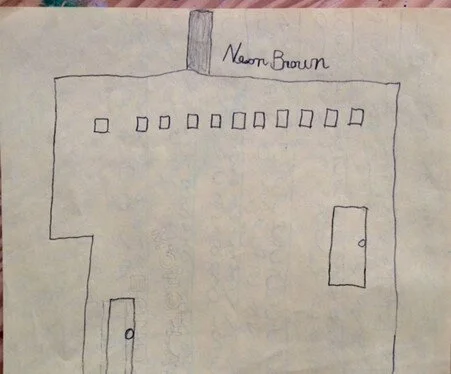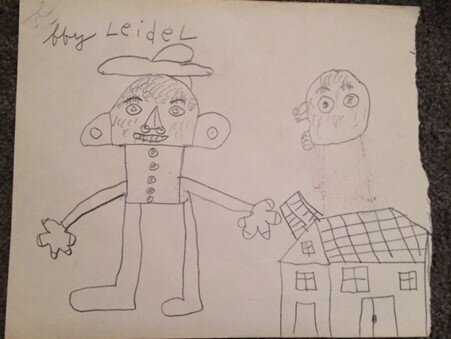Pennhurst asylum 2017
Pennhurst around 1920s
Pennhurst asylum for people with intellectual disabilities and “brain damage” operated from 1908 to 1987. I worked there from 1970 to 1972 as a Therapeutic Activities Worker II. I visited the grounds in 2017 with my dog, thus this report.
“During eight decades of continuous operation (1908-87), Pennhurst evolved from a model facility into the subject of tremendous public scandal and controversy before the federal courts ordered it closed and the remaining residents moved elsewhere. Twenty years after its closure, the Pennhurst campus was recognized as an International Site of Conscience and its history became associated with a national and international disability civil rights movement. The Pennhurst story serves as a reminder of Philadelphia and Pennsylvania’s critical role in one of the great freedom struggles in contemporary history.
“Opened in 1908 as the Eastern Pennsylvania Institution for the Feeble Minded and Epileptic, but better known by its popular name, Pennhurst was part of a national trend to segregate individuals with intellectual and developmental disabilities (then referred to as “defective”, “degenerate” and “unfit”) from mainstream society.”
https://philadelphiaencyclopedia.org/archive/pennhurst-state-school-and-hospital/
Pennhurst asylum 2017
A walk-through Pennhurst memories
(January 19, 2017)
Joe Szimhart
A couple of days ago, my dog Aria and I strolled further down a familiar trail along the Schuylkill River south of Royersford. We happened upon this sign:
The sign referred to a haunted house extravaganza in one of the abandoned asylum buildings that has been especially popular during the Hallowe'en period.
Pennhurst State School and Hospital opened in 1897 as the Polk Center for people with intellectual disabilities. By 1903 it expanded into Eastern State Institution for the Feeble-Minded and Epileptic. In its early phase, Pennhurst was a model campus with the cutting-edge treatments of the day. Pennhurst housed and treated around 10,000 human beings over its history. In 1955, the population peaked at 3,500 "brain damaged and retarded" adults and children, many of whom arrived as kids and lived out their lives within the world of an asylum.
Pennhurst was overcrowded within a decade of its inception, so abuses naturally occurred within its authoritarian model. In 1968, major abuses were recorded by an investigative television report that had a national impact. Pennhurst became one of the first large warehousing facilities for marginalized, mentally disabled people to begin a shutting down process in the 1970s. By 1987, Pennhurst was closed save for a small portion repurposed for treating military veterans.
Most residents were evaluated and moved to county-based facilities or merged into the general population. Today, these old asylums are either totally shut down or treat a remaining, small percentage of very difficult cases. I work today on the grounds of Norristown State Hospital for a private psychiatric emergency hospital that rents Building 50 on the old Norristown campus. NSH was originally in 1880 called State Hospital for Lunatics at Norristown.
In 1970, I was hired at Pennhurst and worked there for two years, mainly to save money for art school. In one of my jobs, I was trained to supervise a small evaluation program to test and train higher functioning residents to work in sheltered workshops. The work included sorting and bagging small objects like buttons, screws, nuts, and bolts for manufacturers. The IQs of my adult Pennhurst students ranged from 45 through 70.
Aria exploring a drainage arch in wall surrounding the campus
we enter campus
As the dog and I explored the quiet grounds, old memories emerged from buildings like disturbed ghosts. Around 1,500 residents remained on the campus in 1970, when I started work there. To this day, I retain a relationship with several co-workers from that era. Most have passed on. New policies brought in new hires of mostly young workers, some fresh out of college like me, interested in social service careers. I took the job to save money for art school.
The early 1970s were a vibrant time for social changes. Rules for attire on the job were loose. Clean and decent for general staff was all that mattered, but women shed their bras, men wore hair long, both sexes appeared in bell-bottomed jeans with patches, and some wore beaded accessories and headbands. Psychotropic drugs and war protests fed the cultural ferment. "Be Here Now" by Ram Dass was popular reading. Neil Young released his Harvest album in 1972 with his hit song "Heart of Gold." J. Gregory (Greg) Pirmann, an old friend from those days, dedicated his career to social service and worked at Pennhurst until it closed in 1986. Greg has been a driving force behind the Pennhurst memorial effort. http://www.preservepennhurst.org/
But the people I most recall were the residents. I was not prepared for the shock of what I encountered on my first day of orientation in 1970 at age 22. I had encountered misfits and mentally deficient folks before, but not in such mass concentration. One ward was a scene out of a zombie movie in which the lowest functioning ambulatory males, whose intellectual capacity prevented them from speech and appropriate emotional expression, wandered about in aimless fashion either naked or in hospital gowns, most not able to feed or toilet themselves. Some might masturbate without concern for onlookers. IQ lower than 25 or "profoundly retarded".
During interviews and sessions at the test site, I often sketched residents on letter-sized paper. I gave sketches away to the residents and to staff, but managed to retain others, some of which you can see below.
There were a few residents on the grounds officially labelled gargoyles, adults with such disturbing features that only a medieval gargoyle sculpture could capture the look. Others were chronically bedridden and were treated like babies, but they were in their twenties and older if they survived that long. Mongoloidism or Downs Syndrome was common among the population.
Maria posed for me several times. She was a sweet person.
My clients were among the higher-functioning residents who had acceptable verbal skills and some writing skill, up to second or third grade level. Nearly all highest functioning residents had been placed, many able to perform manual labor or simple factory jobs, by the time I arrived. As a result, most maintenance jobs at Pennhurst had to be replaced by new staff.
One of the students in my sheltered workshop testing and training program was Harry Callahan. He was an oversized fellow with what some staff called "idiot savant" traits. Harry could whistle any classical tune from memory if he heard it once. He had a thoughtful air about him and he smoked a pipe. However, no matter how we tried, we could not teach Harry to sort and pack nuts and bolts properly. He consistently messed up the count and sizes. Below is a sketch I did of Harry. He was one of the rare few who attempted to sketch me. Yes, my hair was very long.
Harry’s sketch of me
my sketch of Harry
Larry Taylor, in a sketch below, was a middle-aged man, perhaps in his early 40s, who had a fixation on Elmira, NY where he claimed he had family. He knew an address. One of my colleagues, John Lang, took time off and got permission to drive Larry to Elmira, a place he had not seen since age ten. They returned empty handed, no such address existed, and Larry could not recognize any landmarks. Larry was not able to perform well enough to pass sheltered workshop tests. His IQ may have been 45 or 50.
Larry
Batman by Lawrence Taylor
by David, and adult (see below)
Divine Light Mission and a Pennhurst runaway
One young resident, age 17, lived in the locked male ward due to chronic elopements. I met Jimmy after police returned him from New York City where he managed to get to weeks before. This ward had one male staff per five residents and was notorious for the most dangerous residents. Population at the time was less than 20. I visited the ward daily, as a few potential sheltered workshop clients lived there. Two adolescent runaways, including Jimmy were held there with the violent males. I had to help pull them apart from violent encounters a few times
When I first laid eyes on him, Jimmy was sitting in a corner in a lotus position under a sheet appearing to meditate. I was curious, so I asked him why? After he landed in Manhattan via several rides hitchhiking, he sat in a park where a couple of young religious group members asked him to come to a meeting where he could get a free meal. The group was Divine Light Mission, at the time one of the more notorious new religious movements or cults in the USA. DLM was from India and was established in USA in 1971 by the family of a then 13-year-old guru who was promoted as the living godman of the cult.
https://en.wikipedia.org/wiki/Divine_Light_Mission
DLM today is known as Elan Vital. As DLM, it gained around 10,000 members by the mid-1970s. Derivative of Sant Mat teachings, a sect of the Sikh religion in India, DLM taught "knowledge" or a form a gnosis or enlightenment gained by initiation into a style of meditation.
Jimmy said he was practicing the "knowledge." He was a hyper-verbal person, getting very animated when describing his adventures. He was not "retarded" with an IQ higher than 70, but he may have had a severe form of what was later described as Attention Deficit or ADHD. His family placed him in Pennhurst at age ten because he was too hard to handle.
the abandoned locked ward for dangerous male adults (2017)
Below are sketches by adult residents I collected in 1972 with notes.
Beatrice drew this image of her obsessive memory
adult sketch
Adult art by a violent male resident on locked ward. He would produce ten sketches like this in a short time, perhaps five to ten minutes.
Adult art
Adult art
Adult drawing
“God” by adult resident
“this a big place where all people go when they die”
Some sketches of Pennhurst residents I did around 1972
Anna getting coffee
Anna with her coffee
Carl, mostly blind
an teenage resident at Pennhurst
A vent structure above the asylum’s extensive tunnel system that connected all buildings.
They all smelled of urine when I worked there in the early 1970s
































